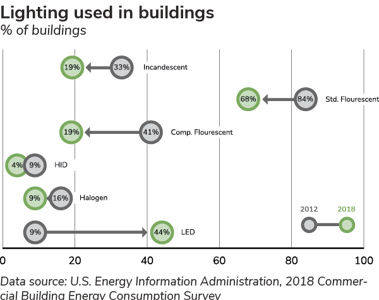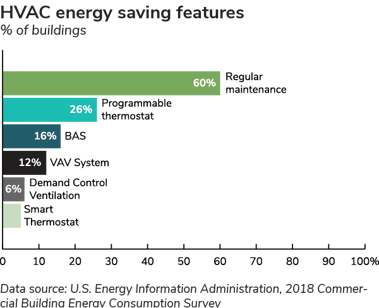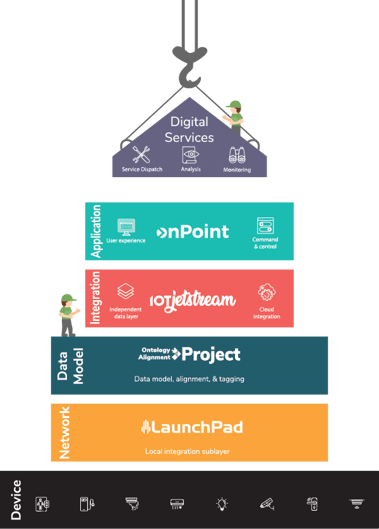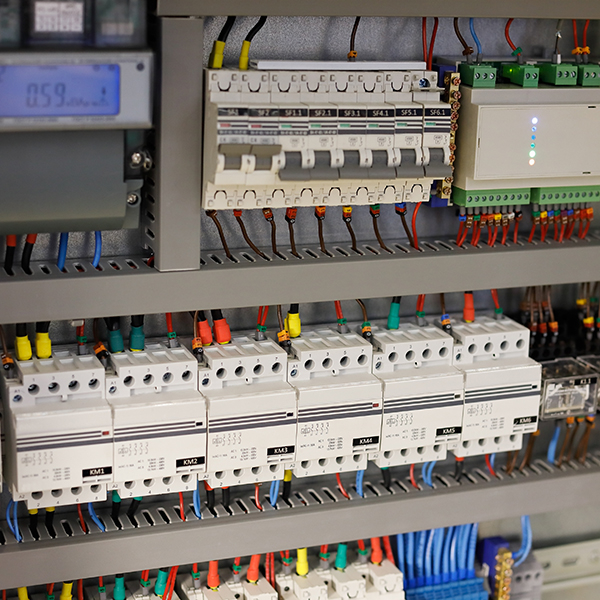Guide to Building Energy Management
A comprehensive guide to energy and sustainability programs for commercial portfolios.
Energy has always been a significant expense in commercial buildings and improving energy efficiency has long been an important way to keep costs in check.
The U.S. Department of Energy estimates that commercial buildings in the U.S. account for 18% of primary energy use, leading to energy expenditures worth $190 billion each year.
But the impact isn’t just economic; energy use in commercial properties produces 826 million metric tons of carbon dioxide emissions annually. Companies are faced with mounting pressure from both the societal and governmental fronts to address their impact on the environment.
The good news, according to the U.S. Energy Information Administration (EIA)’s Annual Energy Outlook, approximately 30% of the energy used by commercial buildings is wasted. This means that with proper processes, best practices, and supporting technologies, many corporate leaders can make significant progress towards energy efficiency and improved carbon footprints.

The state of energy usage in commercial buildings
Let’s start by exploring the current state of energy consumption in the commercial real estate sector.
Commercial buildings in the U.S. account for 18% of primary energy use within the country. While 18% may seem like a small piece of the energy use pie, the actual amount of energy used by the U.S. commercial building sector accounts for more than that of the entire country of Canada.
Lighting and heating ventilation and air conditioning cooling (HVAC) account for the majority of this energy consumption.

Lighting Usage
Lighting accounts for 17% of all energy consumed in commercial buildings across the U.S. and is one of the largest sources of total electricity consumption in the commercial sector. The lighting consumption of a building is primarily driven by its purpose.
The activities within buildings determine lighting usage. For instance, in food sales, healthcare, and education, most of the floor space is lit either around the clock or for a significant portion of the day due to extended business hours.
Though lighting accounts for a significant portfolio of energy consumption among commercial buildings, progress continues to improve in efficiency and usage across the sector.
Today, LEDs are the most energy-efficient and durable type of directional lighting. LEDs provide the same brightness and convention bulbs but consume 90% less energy than incandescent and compact fluorescent (CFL) lighting.

Heating Ventilation and Air Conditioning (HVAC)
Space heating, ventilation, and air conditioning (HVAC) account for more than 30% of total energy usage within most commercial buildings.
Inefficient energy usage in HVAC results in increased energy consumption and carbon emissions by commercial establishments. As our climate becomes warmer, commercial demand for cooling continues to apply increasing pressure on the power grid. Further, the associated price fluctuations in the energy market add to the unpredictability of energy costs for commercial buildings.
While more than half of commercial buildings perform regular HVAC maintenance, efficiency measures largely stop there. Programmable thermostats, building automation systems (BASs), variable air volume (VAV) systems, demand-controlled ventilation (DCV), IoT smart thermostats, and dedicated outside air systems (DOAS) are all HVAC systems that significantly contribute to energy efficiency optimization – however, less than 22% of commercial space within the U.S. leverages any one of these features.
Energy Use by Industry and Location
Energy use in different types of real estate assets focuses on different factors. For instance, an office building’s energy usage focuses on occupant comfort, health, and productivity while a food service facility may focus on cooking equipment and refrigeration systems.
The top five energy-consuming building categories used about half of the energy consumed by all commercial buildings in the Energy Information Administration’s most recent survey. Retail buildings led the pack in energy consumption, representing 15% of total energy consumed by commercial buildings. Office space flowed closely behind, representing 14%.
When considering location, buildings in the South U.S. account for more than one-third of total commercial building energy consumption. This is due to buildings in this region tending to be larger and accounting for more floorspace.
Building energy management solutions and strategies
U.S. commercial building energy expenditures are staggering. Today’s businesses, governments, and commercial sites spend $190 billion every year on energy-related costs.
There is a pressing need for today’s businesses to implement strategic and efficient processes to achieve energy efficiency. The potential for today’s businesses to reduce commercial energy consumption is substantial – an average of 30% of the site energy consumption in commercial buildings is wasted. Energy savings solutions can help achieve a significant reduction in costs, help meet regulatory obligations, and improve societal sentiment towards your organization.
Here are some processes and best practices to help you achieve energy efficiency across your real estate portfolio.
Make your portfolio smart
One of the first considerations many energy and sustainability managers take to boost energy efficiency across their portfolio is to invest in more efficient equipment. While that can be a good start, smart technology is the key to optimizing efficiency.
Making your portfolio smart begins with unifying building systems, strategically adding IoT devices, and integrating the data from those systems and devices.
Integration is a key step in making your portfolio smart. It allows you to gain insights into your energy consumption data so that you can identify energy efficiency opportunities easily.
Building energy management systems with smart analytics can often offer energy savings between 3% and 9% over a two-year period. However those savings jump significantly to between 10% and 25% or more on average when you deploy intelligent analytics with the guidance of a controls and master system integration (MSI) expert.
Use machine learning to improve energy efficiency
Building energy management systems that leverage machine learning analytics are gaining ground in the commercial buildings industry due to their ability to uncover patterns, produce accurate predictions, and automatically respond to those predictions.
Advanced machine learning technologies can help you identify energy-saving opportunities and even reduce or offset commercial building peak load that would otherwise not be apparent while minimizing reliance on human intervention to identify and resolve operations problems.
Four key ways machine learning can optimize building energy efficiency are:
- Forecasting energy consumption
- Detecting and predicting faults
- Modeling seasonality
- Modeling pre-cooling and pre-heating
Implement predictive maintenance
Historically, building maintenance has been largely time-based or corrective, but following arbitrary maintenance schedules or reacting to problems when they become apparent can result in the oversight of energy inefficiencies.
Even small performance losses due to ill-timed preventive maintenance can result in significant energy waste and major malfunctions can cause energy consumption and costs to skyrocket even in the short time it takes to schedule and perform energy maintenance.
With predictive maintenance, malfunctions and inefficiencies are addressed in the earliest stages – or often even before they start.
A robust predictive maintenance plan depends on several things:
- Data collection and storage
- Data processing and active monitoring
- Fault detection and diagnostics
Adopt ongoing commissioning
The increasing complexity of building systems makes commissioning essential to ensure proper installation and performance.
Monitoring your portfolio’s data sources on an ongoing basis is key to allowing the implementation of meaningful energy management programs that produce actual results.
Ongoing commissioning allows for the implementation of preventive and predictive maintenance. This reduces the chance of unplanned breakdowns or excessive energy usage that results in high energy inefficiencies.
Technologies and building energy management solutions
Technology has enabled building energy management to progress incredible strides over the last several decades.
Even if your existing portfolio isn’t “smart” the technologies that reside within each building and space are still complex and as buildings become more and more intelligent, this complexity increases exponentially.
You don’t need to be a technology expert to implement a successful energy management program but understanding technology’s role is a crucial step.

Building equipment and systems
Building equipment and systems are the original technology of buildings having existed in modern buildings from the beginning. Building equipment and systems keep the building running and healthy.
Common building systems include:
- HVAC
- Lighting
- Access control
- Plumbing
- Fire protection/Life-safety
- Electrical systems
- Elevators
- CCTV
Each of these systems is made up of various components that must quickly and easily communicate with other components within the system to facilitate their functionality. For the most part, thanks to open communication protocols like BACnet and Modbus, each of these systems are designed to easily communicate within itself – using the same communication protocols throughout.
However, this isn’t always the case. This is where a system integrator comes in. A system integrator focuses on aligning the different communication protocols and data points of the various components that make up a system so that things like a thermostat can transmit data to and from a fan coil unit or air handler unit. Without this basic integration, even the most rudimentary energy management programs are not feasible.

Operational Technology (OT) network
All these building systems are typically connected to the building’s operational technology (OT) network. The OT network makes it possible to connect systems and enables the implementation of building management systems (BMSs). It also creates a secure highway for data to transmit to the cloud.
With the addition of Internet of Things (IoT) devices and cloud networks OT has evolved in recent years. The combination of on-premises equipment such as system and equipment controllers coupled with smart devices such as IoT thermostats necessitates edge controllers and integration supervisors that securely connect field devices and equipment to the cloud.
Data models, ontologies, and integration platforms
Data is the foundation of a successful smart building energy management program. For it to solve energy inefficiencies, it must be modeled, aligned, and integrated seamlessly. This requires careful consideration of data models, ontologies, ontology alignment, and effective smart building integration platforms.
- Data models and ontologies
In smart buildings, devices, software, and building equipment must work together to drive efficiencies. This requires unifying several naming and tagging standards currently used for building automation. While a seemingly simple issue, many data modeling approaches create roadblocks to the real-world application of energy consumption data. Numerous organizations have identified the data naming standard challenge and agree that a common ontology is necessary to solve the problem – creating their own solutions but simultaneously creating a new problem: no common solution. - Ontology alignment
Understanding this dilemma, the Ontology Alignment Project (OAP) establishes an open-source taxonomy using distinctive coding to automatically translate other ontologies and allow energy managers to take advantage of technologies that work under different protocols. - Integration platforms
A smart building integration platform serves as the brains of a smart building. It empowers the delivery of innovative energy management and operational solutions by unlocking interoperability between connected systems. Without a smart building integration platform, “smart” doesn’t happen. Integration platforms deliver useful data to and from the applications and user interfaces that humans interact with to make informed decisions regarding building operations and energy efficiency.
Applications and user interfaces
Perhaps the most familiar technologies to energy and sustainability managers are the ones they interact with daily. These are the applications, platforms, and user interfaces that bring everything together to enable human interaction with the underlying data of building systems, equipment, and environmental factors that affect energy consumption.
There are dozens of options for applications and user interfaces with new ones being developed almost daily. Many energy management software solutions are disguised as others, and numerous applications serve multiple purposes making it confusing to understand which type of application is appropriate.
Because of this, instead of discussing the different applications and user interfaces on the market, here are some features and capabilities that energy and sustainability managers should look for in a solution, regardless of its name.
Integration capabilitiesRegardless of the type of application you choose, it should reduce – not create more – operational siloes. This means it should be built upon a capable smart building integration platform that enables interoperability between systems and it should enable command and control of connected systems to help improve productivity. |
|
Analytics and insightsOne of the most valuable aspects of a management application for energy and sustainability managers is its ability to uncover new opportunities for energy efficiency. It should provide easy access to analysis and insights that reduce guesswork and streamline solutions. |
|
Predictive maintenance and machine learningA management application should leverage machine learning intelligence to inform predictive maintenance. As mentioned before, predictive maintenance is one of the most valuable tools for reducing excessive energy waste. |
|
ReportingThe ability to report on energy management and reduction data is crucial to gaining support, measuring success, and communicating efforts to stakeholders. A management application should enable you to set the frequency, sharing capabilities, and information that is shared in reports. |
|
Digital servicesDigital services is the active monitoring of the data and insights produced by your building systems to help optimize performance and support energy efficiency initiatives. While digital services aren’t necessary to implement an effective energy management strategy, they can often be the difference between reactive and proactive solutions without the need for additional personnel. Ensuring that the solution you choose has the ability to add digital services support can ensure that your program never falls behind. |
|
ScalabilityA management platform should offer a centralized location for building data, analysis, reporting, and control for all of your portfolio’s equipment, spaces, and buildings. It should provide the ability to quickly onboard new assets so that you can easily leverage its capabilities, machine learning, and other features all from a single, easily accessible point. |
|
SecurityThe solution you choose should be able to provide clear and concise documentation on its cybersecurity measures, protocols, and practices. Some particular features to look for are user authentication, encrypted traffic, JSON Web Tokens, subnets and load balancers, TLS authentication, and zero trust. |

onPoint is a cloud-based smart building application and management platform that enables building operators, energy managers, contractors, and owners to stay on top of the most valuable aspects of their portfolio. With a focus on system-wide energy use, occupant comfort and health, and ongoing operations, onPoint is a comprehensive building analytics package that deliver better more reliable data.
Features include:
- Command and control
- Building data modeling
- Insights and reporting
- Automation and work requests
- CMMS, CRM, and BI integration
Financing and funding an energy management project
Energy has always been a significant expense in commercial buildings and improving energy efficiency has long been an important way to keep costs in check.
Often, an energy management project pays for itself over the course of several years. However, the upfront capital investment and ongoing operating costs for maintaining the project may not be budgeted for or high on a finance or even a facility management team’s priorities. Justifying the financial investment for an energy management program can be difficult for several reasons.
- Lack of understanding from those holding the purse strings
- Competing projects
- Large up-front capital expenses
Fortunately, there are several strategies that can help free up funds, or even create funds, for energy management projects. Funding is divided into two categories: internal and external. Among these two categories, there are various options depending on your unique situation.
Internal funding
Internal funding refers to the process of funding energy efficiency projects using an organization’s own financial resources. This option is often the most straightforward and most valuable as it ensures that an organization reaps the full benefits of energy optimization efforts.
Some options for internal funding include:
- Operating and capital budget expenditures
- Self-funded Energy Savings Performance Contracts
- Capital Investment Funds
- Revolving Loan Funds (RFL)
- Internal Carbon Price
External funding
Energy efficiency projects can often be capital intensive and require significant funds to execute. Despite nearly all investments having a positive return on investment over time, they may just simply not be feasible to execute due to capital constraints.
Despite this, society, governments, and utility providers recognize the benefits that corporate energy programs provide us and there are many resources for corporations to leverage to help fund necessary projects that attribute to minimizing their carbon footprint. Along with traditional commercial loans, incentives and rebates, and bonds, specialized energy-specific financing options are also available for energy projects.
These include:
- On-bill financing (OBF) and repayment (OBR)
- Commercial property Assessed Clean Energy (CPACE)
- Green bonds
Overcoming objections from finance teams
Convincing financing departments that investing in sustainable energy-saving efforts can present a significant barrier to getting and sustaining corporate funding for energy efficiency projects.
One strategy is to show proof of concept with low-hanging fruit energy efficiency projects that result in monetary savings. Starting with low-hanging fruit should demonstrate the links between energy efficiency, corporate responsibility, and cost savings to attract the interest of finance.
Leveraging a smart building application that enables data analysis can help you quickly validate low-hanging fruit projects and provide backup for easier buy-in on future projects. A smart building application can also serve as a low-hanging fruit itself by providing insights into quick-hit energy efficiency opportunities.
Data-driven building energy management helps you reduce costs and carbon emissions
Demand for energy efficiency and sustainability among organizations across the world only continues to grow as the effect of carbon emissions on our environment becomes more apparent. Buildings play a critical role in an organization’s ability to reduce its carbon footprint. Leveraging smart building technologies designed to help reduce energy consumption, improve efficiency, and gain stakeholder buy-in is a crucial step in implementing a successful strategy.
Ensuring you have the right strategies, technologies, and funding in place to execute your strategies and champion energy efficiency for your organization starts with data. Start your journey by exploring the technologies that enable you to access, analyze, inform, and control energy consumption across your organization’s real estate portfolio.
If you're ready to start your journey and explore your options, click the button below to schedule a no-obligation discovery session with a smart building expert.
